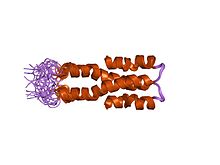| H-NS | |||||||||
|---|---|---|---|---|---|---|---|---|---|
 Solution structure of the N-terminal domain (oligomerization domain) of the bacterial nucleoid structuring protein, H-NS. | |||||||||
| Identifiers | |||||||||
| Symbol | H-NS | ||||||||
| Pfam | PF00816 | ||||||||
| InterPro | IPR001801 | ||||||||
| CATH | [ P0ACF8] | ||||||||
| SCOP2 | 1hns / SCOPe / SUPFAM | ||||||||
| |||||||||
Histone-like nucleoid-structuring protein (H-NS), is one of twelve nucleoid-associated proteins (NAPs)[1] whose main function is the organization of genetic material, including the regulation of gene expression via xenogeneic silencing.[2] H-NS is characterized by an N-terminal domain (NTD) consisting of two dimerization sites, a linker region that is unstructured and a C-terminal domain (CTD) that is responsible for DNA-binding.[2] Though it is a small protein (15 kDa),[3] it provides essential nucleoid compaction and regulation of genes (mainly silencing)[2] and is highly expressed, functioning as a dimer or multimer.[3] Change in temperature causes H-NS to be dissociated from the DNA duplex, allowing for transcription by RNA polymerase, and in specific regions lead to pathogenic cascades in enterobacteria such as Escherichia coli and the four Shigella species.[3]

- ^ Winardhi RS, Yan J, Kenney LJ (October 2015). "H-NS Regulates Gene Expression and Compacts the Nucleoid: Insights from Single-Molecule Experiments". Biophysical Journal. 109 (7): 1321–1329. Bibcode:2015BpJ...109.1321W. doi:10.1016/j.bpj.2015.08.016. PMC 4601063. PMID 26445432.
- ^ a b c d Qin L, Erkelens AM, Ben Bdira F, Dame RT (December 2019). "The architects of bacterial DNA bridges: a structurally and functionally conserved family of proteins". Open Biology. 9 (12): 190223. doi:10.1098/rsob.190223. PMC 6936261. PMID 31795918.
- ^ a b c Picker MA, Wing HJ (December 2016). "H-NS, Its Family Members and Their Regulation of Virulence Genes in Shigella Species". Genes. 7 (12): 112. doi:10.3390/genes7120112. PMC 5192488. PMID 27916940.
- ^ Shindo H, Iwaki T, Ieda R, Kurumizaka H, Ueguchi C, Mizuno T, et al. (February 1995). "Solution structure of the DNA binding domain of a nucleoid-associated protein, H-NS, from Escherichia coli". FEBS Letters. 360 (2): 125–131. doi:10.1016/0014-5793(95)00079-o. PMID 7875316. S2CID 44479751.
